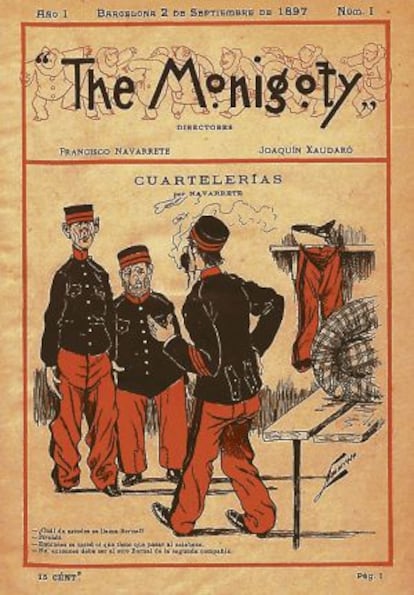Three hundred years of Spanish comics
The Tebeosfera project has already catalogued 17,000 titles The organization now has 93 members and 180 volunteers


Most had lain forgotten for years in attics, chests and old boxes. But enthusiasm, personal interest and volunteer work has enabled thousands of them to see the light again. A project that Manuel Barrero, 46, began as a personal passion has produced a catalogue of 17,000 comic strip titles published from the 19th century to the present day.
Barrero says that newspaper cartoons were particularly interesting in the early days. “But unfortunately for this country, those are the ones preserved in worst condition, and the newspaper archives do not keep copies of everything that was ever published. Part of Spain’s graphic history has been lost out of neglect in a country like ours, which is incapable of caring for many aspects of its own culture.”
The Tebeosfera project, says Barrero, began in 2001 with the goal of “understanding, studying and disseminating the cartoon medium, [...] which encompasses graphic humor.” Tebeosfera now has 93 members and 180 volunteers from Spain and elsewhere working together on the compilation venture. The main workspace is the website (www.tebeosfera.com), but there are also group activities and related publications, chiefly magazines, books and catalogues. Tebeosfera’s first printed catalogue was presented at the 30th Barcelona comic book fair, the Salón del Cómic de Barcelona.
Barrero was pushed to undertake the project by his doctoral dissertation, which remains uncompleted because of the vast amount of time he spends on his great passion. “When we started out, we thought there would be around 7,000 comic books published in Spain, but at the present moment we have catalogued 17,000 collections,” he says.
'Dominguín' was the first Spanish magazine with full-color strips
Contributors to the project, adds Barrero, pay “special attention to coming at this from an academic perspective in all its manifestations, from semiology to narrative, historiography and sociology. This includes the project to catalog all publications containing strips, as well as children’s publications and the satirical press, which is something that had never been done seriously in this country before.”
Tebeosfera has so far created 182,369 files, located 15,801 authors and identified 17,003 collections. Some of the jewels that have turned up during the course of the research include a cover of The Monigoty, one of the first Spanish comic strips of the 19th century; a cover of Le Pêle-Mêle, a French magazine published in Spain that reportedly provided inspiration for the famous TBO comic book; and a copy of Charlot, which featured contributions from writer, journalist and politician Vicente Blasco Ibáñez.
Tebeosfera contributors have also unearthed a copy of Dominguín, the first Spanish magazine with full-color strips, which dates back to 1916. Juanito was another of the team’s great finds. It is a small comic book that was published before the seminal TBO saw the light.
One of the most valuable items is, in fact, a cover of TBO drawn by Opisso, an excellent artist from the era. And there is the copy of Pocholo, a comic book from the 1930s. But Pulgarcito, says Barrero, is “our most interesting title, in this case with Laurel & Hardy participating in the Civil War, which had not yet ended.” Although the target audience was predominantly male, there was a collection titled Mis chicas (My girls) for young female readers. Other noteworthy finds include an issue of Clarín, Franco’s own propaganda comic.
Tu suscripción se está usando en otro dispositivo
¿Quieres añadir otro usuario a tu suscripción?
Si continúas leyendo en este dispositivo, no se podrá leer en el otro.
FlechaTu suscripción se está usando en otro dispositivo y solo puedes acceder a EL PAÍS desde un dispositivo a la vez.
Si quieres compartir tu cuenta, cambia tu suscripción a la modalidad Premium, así podrás añadir otro usuario. Cada uno accederá con su propia cuenta de email, lo que os permitirá personalizar vuestra experiencia en EL PAÍS.
¿Tienes una suscripción de empresa? Accede aquí para contratar más cuentas.
En el caso de no saber quién está usando tu cuenta, te recomendamos cambiar tu contraseña aquí.
Si decides continuar compartiendo tu cuenta, este mensaje se mostrará en tu dispositivo y en el de la otra persona que está usando tu cuenta de forma indefinida, afectando a tu experiencia de lectura. Puedes consultar aquí los términos y condiciones de la suscripción digital.
Últimas noticias
Sinaloa Cartel war is taking its toll on Los Chapitos
Venezuela hardens its ‘revolutionary state’ project amid pressure from Trump
Sydney Sweeney, the actress praised by Trump: ‘Women are up against what society wants them to be’
The Bolsonaro surname: An advantage or liability in Brazil’s 2026 presidential elections?
Most viewed
- Reinhard Genzel, Nobel laureate in physics: ‘One-minute videos will never give you the truth’
- Pablo Escobar’s hippos: A serious environmental problem, 40 years on
- Charles Dubouloz, mountaineering star, retires at 36 with a farewell tour inspired by Walter Bonatti
- Why we lost the habit of sleeping in two segments and how that changed our sense of time
- The fall of a prolific science journal exposes the billion-dollar profits of scientific publishing








































